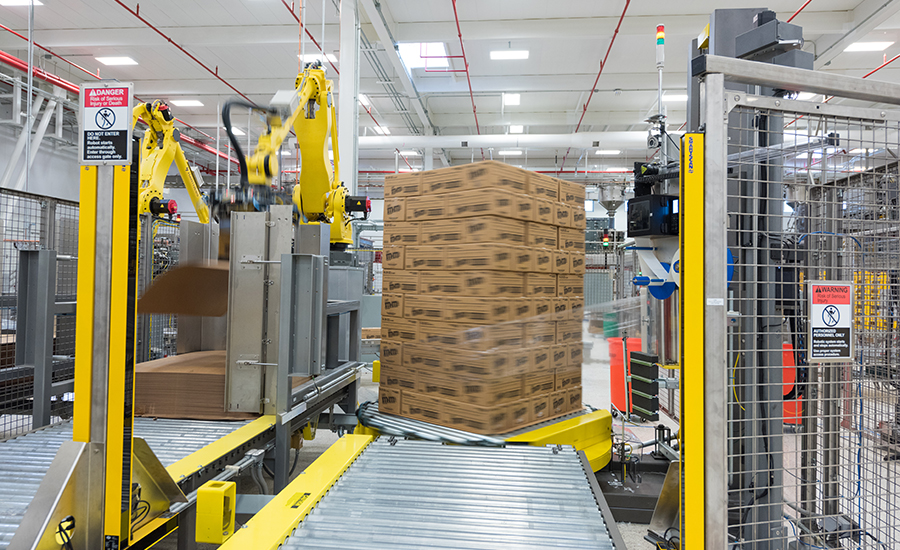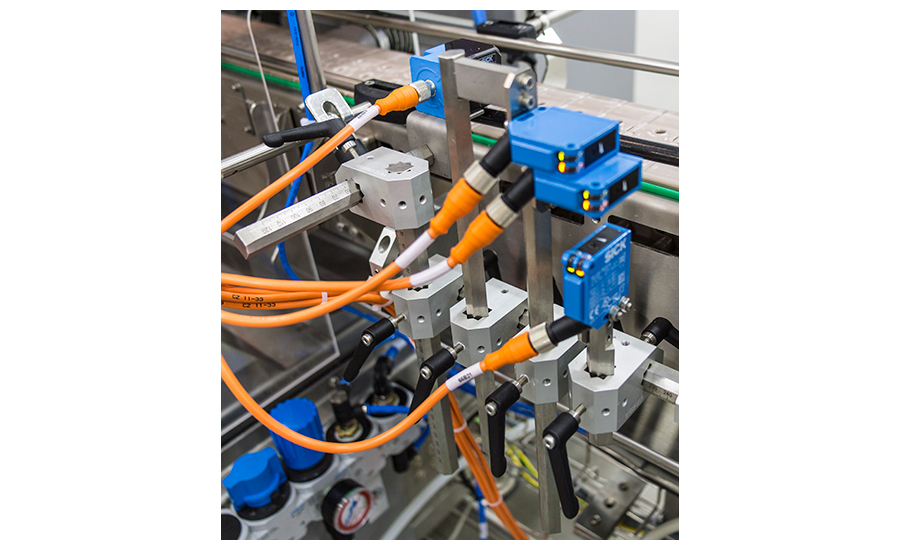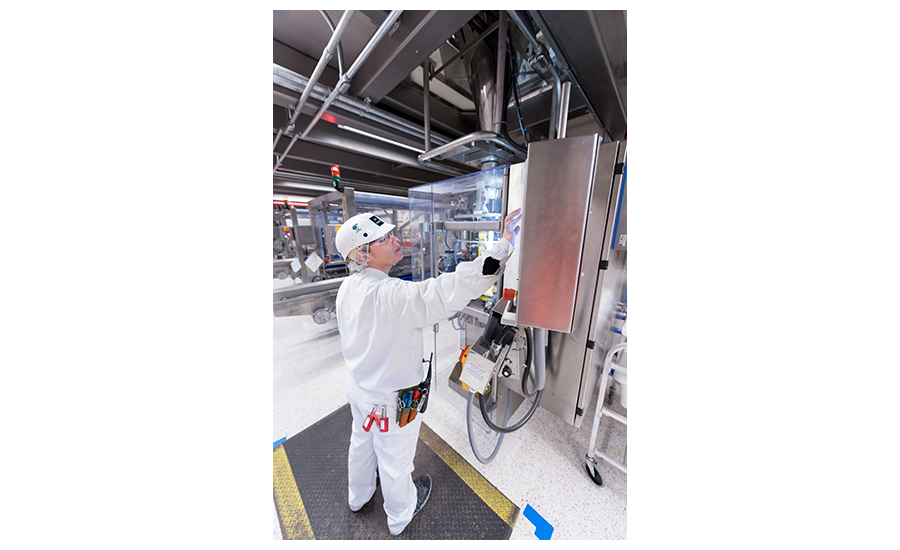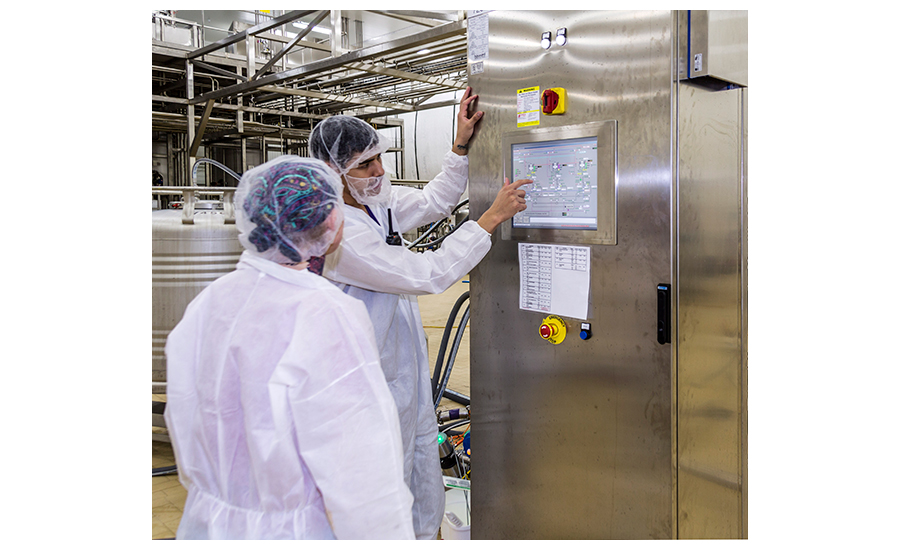System Integration
Choosing and working with a system integrator
Think of a system integrator as an extension of your own engineering team, one who will work with you for years to come

On-site system integrators set up and configure new production lines before final acceptance testing. Photo courtesy of Ross Van Pelt (RVP Photography)
Many large food and beverage manufacturers have their own engineering staffs, which provide system integration and automation services to their various facilities. However, most medium- and small-sized processors often don’t have these capabilities—and may have just a single plant engineer.
Therefore, for any number of reasons, a food processor may need to look for a system integrator (SI) to help with its automation strategy, whether to update aging and existing automation systems or plan new automation strategies that could require complete revamps or new facilities. First, we look at the basics in choosing a system integrator, and second, we look at the ways a food processor can work with a SI to plan a successful automation strategy.
A marriage made in heaven?
Well, maybe not so much, but unlike locating and calling a plumber who has Saturday hours solely to fix a leaking pipe, finding and choosing a system integrator should result in a long-term relationship that is mutually beneficial for both food processor and the SI. It’s a relationship that can result in tangible and intangible rewards for both partners: For the processor, the benefits of a modern plant and controls that provide a competitive edge—and for the SI, the satisfaction of a job well done while both partners are learning new technologies and operational methods.
And as with any partner, you’ll find that SIs have their unique “personalities”—which means the right match may take a little research. Try looking at SI web pages and especially customer/client comments to start. Talk to other food companies who’ve employed SIs and get referrals.
For processors with certain needs over the long haul, the choice of a SI should align with those needs. A good resource for locating an integrator is the Control System Integrators Association, which I mentioned above. You can log onto the home page at https://www.controlsys.org and click on the “Find an Integrator” tab.
Know your company’s needs before choosing an SI
As with any proposed relationship, there are obviously several selection criteria you can apply to choosing an SI, but I wondered if it first doesn’t hurt to perform a little introspection.
“Yes. Know thyself,” says Bachelor Controls’ Jessica Bennett, operations manager. “From Plato, to the Bible, to many other writings, this is a concept that many individuals follow. This can be applied to an organization as well. What are your goals? Where are you going? Why are you here? How do I want to proceed? Having answers to these questions and understanding your goals, will help determine the SI that would best serve [your] needs.”

Once the goals are understood, a manufacturer should look for an SI who can work with the processor to help translate those needs to the automation world. The SI should be a partner that will spend time not just trying to win a processor’s business but an integrator who will work to help improve a process and continue working to see that the client’s business prospers, says Bennett.
The processor should have a series of questions to ask the SI as they review their needs and should also hold back some information and allow the SI to ask pertinent questions. Through these questions, the types, complexity and understanding of these questions, the manufacturer will gain deeper insights to the competency of the SI, Bennett adds.
“I would consider the distinct need, such as—is the manufacturer looking for an integrator for ongoing support, maintenance, and incremental improvements, or is this project-based?” asks Black & Veatch’s David Ziskind, director of engineering. “For a project, I believe in starting with a controls specification and requirements document. The manufacturer’s overall strategy is important, and should be articulated in writing, whether by the manufacturer’s in-house automation team or by a third-party design firm.”
Assessing and selecting system integrators
Key questions to ask prospective system integrators:
- Can they provide a list of executed projects and/or client lists?
- Can they provide examples of challenges or lessons learned from previous projects?
- Do they have the adequate resources to support the project?
- How do they handle scope changes?
- Do they understand the corporate and plant goals?
- Do they have experience working with guaranteed maximum prices (GMPs)?
- What is their project implementation methodology?
- How do they approach migrating a complex system with minimal downtime?
- Do they offer startup support?
- How is the knowledge transferred to plant personnel? (As-built documentation? Training? Do they involve technicians and key plant personnel during startup?)
- Is their team available to provide 24/7 support?
- How do they follow up with OEMs on standards?
- Have they implemented any sustainability projects? Can they share best practices?
- Have they previously designed systems that comply with LEED or Green Globes?
— Rao Kolla, Stellar
It’s important to articulate the strategy and get buy-in throughout the organization before starting any programming, says Ziskind. This includes the approach for controls—such as centralized PLC/PAC, MES/ERP, historian, etc. Also, establishing the appropriate level of automation is important—as more is not necessarily better. At the same time, ongoing maintenance/operations strategies should be considered—such that the processor can ultimately operate and maintain the system on its own.
In selecting an SI partner, processors should focus on the culture of the integration company alongside technical prowess, says CEO Walker Mattox, Gray Solutions, a Gray company. A strong partner shares common goals and values and ensures a collaborative teaming environment that leads to a long-term relationship. It’s also important to look for partners that can pull from different technology providers to deliver the right blend of software/hardware technologies, with a focus on those that are open to working with many vendors.
In selecting a SI, processors need to consider their whole picture, especially if they have more than one plant and/or location, says Scott Hodel, director of process engineering and capital project management, Hixson Architecture & Engineering. “Manufacturers needing systems integration capabilities should start by determining their real need for a system integrator: Do they have short-term transactional needs, or do they desire a long-term partnering relationship? Also, for larger, multi-site companies, do they need SI capabilities just at a local level, or do the needs extend company-wide? Many times, we’ll see companies begin at the local level only to discover that other locations have similar SI needs.”

Both single- and multi-site processors face a complex world of cybersecurity concerns, food and ingredient shortages, and environmental/climate factors affecting agriculture, so the race to get and stay ahead will depend on automated and efficient systems producing high-quality products, and the expertise of certified SIs can help as they’re not only subject matter experts on automation, but are also well informed on FDA and other regulations, says Keith Mandachit, engineering manager at Huffman Engineering.
SIs help with extending automation strategies into the future
What capabilities should a SI have to prepare a food processor for tomorrow’s challenges? Mandachit sums it up in one word: Listen. Hearing what the processor has to say about how equipment operates currently and where the processor wants to go in the future is imperative to success. “When you listen well, you can really adapt a system to truly meet the needs of the customer,” says Mandachit.
One way of listening is for the SI to spend time at the plant, both to understand its challenges and to build a relationship with plant personnel, says Rao Kolla, manager of process electrical/controls engineering at Stellar. If the plant’s employees have grown accustomed to a particular system over a length of time, successfully introducing new technology will require buy-in. The SI should align its specifications and recommendations with the facility’s standards, because when all is said and done, plant personnel will have to know how to operate and maintain the system.
The processor needs to make sure the SIs it vets align closely with the processor’s business objectives and each project’s specific needs, says Steve Malyszko, P.E., CEO of Malisko Engineering, a Certified CSIA member. Manufacturing automation covers such a broad spectrum these days that no concise set of “technically-oriented specific capabilities” exists that could cover all projects. Definitely, the chosen SI must have experience and expertise in successfully delivering the specific technology platforms needed to satisfy the scope of the processor’s project. More importantly, regardless of the size and scope of the project, the SI must possess the wherewithal to be an integral member of the processor’s project team and be committed to delivering success to the processor in helping meet the processor’s objectives, schedules and budgets.
“First and foremost, the SI should consider the goal of the project, working with the manufacturer to understand the KPIs and what data is needed to track metrics of improvements,” says Bachelor’s Bennett. Additionally, the SI should look at the maintainability of the system, primarily taking into account the effect of powering down the equipment. Additionally, with the rise of cyber-attacks, the SI should carefully look at the connectivity and network configuration, as well as utilizing cyber security precautions. Finally, the SI should build in methods for flexibility which would lead to the ability to adapt for change in the future.
Are data tracking, asset management and KPI software worth the investment?
These software systems tend to get overlooked because of the upfront cost and the lack of justification based on performance and operations. The cost justification of these systems needs to be viewed in same way as a manufacturer’s backing up critical business data by using redundant servers, cloud storage, or a combination of the two.
For data tracking, the system monitors system inputs and outputs and stores them in a server. If there is an interruption in production, this data provides a way to go back in time to see what caused the issue. This is helpful because it will allow users to review the data rather than waiting for issue to occur again.
For asset management, storing device configuration and programs in a common place and automatically backing them up allows for quick disaster recovery and also provides revision history.
For KPI software, the ability to track real-time production data as well as historical data can be used to identify choke points and justify/verify equipment or process improvements.
All three of these systems allow the owner/operator to utilize the data already generated as actionable information to make decisions related to production, maintenance, and investments.
—Josh Nichols, Dennis Group
Know where you’re starting in planning for the future
“Manufacturers have to face the pragmatic reality of looking at where they are starting from: They have to be able to solve their day-to-day problems and keep plants running,” says Hixson’s Hodel. Processors need to have a thorough, data-driven understanding of their existing condition/operation to plan for the future.
Unfortunately, many manufacturers are still using outdated controls platforms to address their automation needs, says Hodel. While such platforms can and do work, good SIs will meet manufacturers where they are technologically, and help them develop a plan to migrate systems to the desired future state, e.g., elements of Industry 4.0 that they wish to incorporate. They must also be able to execute the work in a phased approach to minimize disruptions to operations.
Prior to the pandemic most small to medium size companies had no business justification or need to join their IT and OT networks, says Josh Nichols, Dennis Group’s senior controls engineer. Now these divisions are becoming more interconnected, especially with the need to remote troubleshoot equipment and systems while still maintaining a secure network. SI’s that understand and have experience joining IT and OT systems is becoming a common requirement today.
While a thorough understanding of all current and leading-edge technology platforms allows for best-in-class solutions at all integration levels, a full service SI has a specific innovation focus that looks ahead five to ten years to build capabilities for tomorrow’s solutions, says Gray’s Mattox. This helps keeps manufacturers ahead of the curve.

While it’s important to look ahead, worrying about how to get there can bog down progress. Bachelor Controls’ Bennett offers advice: “[First], when brainstorming, manufacturers should work on the end result—not the method to get there. Ask, ‘What do I want to see at the completion of this project?’ Also, how is the manufacturer going to measure/prove the success of the project? Second, identify any constraints: Is there a specific date that is required? Is there a specific vendor that is requested? Finally, the manufacturer should keep an open mind and have honest, open, realistic communication with the integrator. If you find a good solution partner, one who will return honest and open communication, the project will run much more efficiently and will be more likely to meet the end goals.”
The processor’s corporate direction is important and should allow for a future strategy in many areas, including product mix, sustainability, centralized vs. decentralized manufacturing and distribution, says Ziskind. Automation and system integration should be used to support the underlying strategy—not necessarily to define it.
Besides product mix, corporate leaders should know what the required throughput is, says Andrew Atwell, CRB project manager. “A few other key items to confirm are available budget, internal return on investment (ROI) requirements, and availability of skilled staff in the area to maintain automation. It is easy to kill a project by attempting to automate further than necessary.”
Corporate direction is important, but planning needs to involve operators. “Know your systems and understand how your personnel utilize the systems,” says Huffman’s Mandachit. This will alleviate any confusion between management and the operators in terms of how your systems currently function and how they need to work into the future. The better an internal team knows and understands one another’s roles and goals, along with how their system operates, the better prepared they will be to be on the same page when discussing automation strategies and plans with a system integrator. “You never want to automate for automation’s sake,” says Mandachit.
Who should attend planning meetings and what should be discussed?
It’s important to define roles and responsibilities, particularly in light of the current meshing of the IT and OT networks, vendor interfaces, software licensing, and installation, says Dennis Group’s Nichols. Stakeholders in operations, maintenance, IT, engineering, and management need to be identified and responsibilities in each area defined. This needs to be done not only at the beginning of the project or activity but revisited throughout the duration.
A great plan involves all team members including safety, quality, operations, maintenance, finance, as well as a best-in-class integration partner, says Gray’s Mattox.
Hixson’s Hodel adds a few more, including management, engineering, quality, safety, operations, purchasing, sales/marketing, and more.

Anyone we forgot to invite? Seems a basic question, but failing to invite a key person could hinder results. “The most important people at the table are the ones who interact with the system every day: operators,” says Bennett. “The operators are going to know what it really takes to run the system; others ‘assume’ they know what it takes. After operators, plant maintenance, and plant personnel are crucial. These are the people who will take ownership of the system after commissioning and who will live with this system for decades to come.”
Additionally, having a good project manager (PM) on the manufacturer side is helpful, says Bennet. This PM could come from the plant or a corporate office. If there are corporate and plant partners, often the SI will be “stuck in the middle” and have to try to meet expectations on both sides. If both sides, corporate personnel and plant personnel, are at the table in the planning, initial phase of the project, the expectations are more likely to be aligned.
Finally, once everyone is at the table, what key issues should be discussed? Probably the most important and potentially overwhelming issue is planning and coping with “digitalization” or “digital transformation,” says Malyszko. Most processors get how important this subject is.
“What we see being more of a challenge is grasping the HOW,” says Malyszko. How does a processor get to a point where they feel confident that they’re heading in the right direction toward effective digitization? Here’s what Malyszko advises:
- Address the question of what business goals, issues or problem solving would you hope to achieve by deploying digitization in your production environment?
- Can you quantify the true value to your company of engaging in a digitization initiative or project?
- Deploy digital technology in a segment of the production operation that will give a processor a tangible return on their investment.
- Engage and invite to the table the multiple stakeholders both inside and outside of their company who will be involved and affected by any digitization initiative.
- Advise processors to engage specialists who understand both the IT and the OT sides on manufacturing to help navigate and plan automation strategies.
Finally, planning for the future of your plant is a challenge, but you don’t have to go it alone. One important thing an SI brings to the table is experience, i.e., in most cases they can say, “Been there, done that,” which means they probably have a leg up on your project. If they haven’t tackled your specific type of project before, you have two options: learn together by tackling your project or go with another SI who has completed a similar project. Either way, it can be a win-win situation.
Looking for a reprint of this article?
From high-res PDFs to custom plaques, order your copy today!







